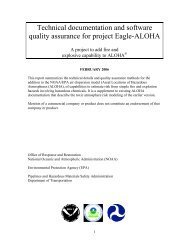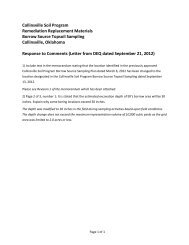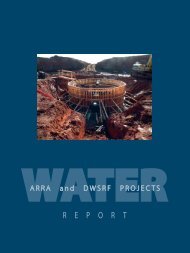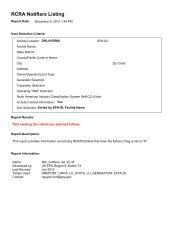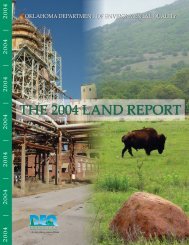Oklahoma Gas & Electric Muskogee Generating Station Best ...
Oklahoma Gas & Electric Muskogee Generating Station Best ...
Oklahoma Gas & Electric Muskogee Generating Station Best ...
You also want an ePaper? Increase the reach of your titles
YUMPU automatically turns print PDFs into web optimized ePapers that Google loves.
<strong>Oklahoma</strong> <strong>Gas</strong> & <strong>Electric</strong><br />
<strong>Muskogee</strong> <strong>Generating</strong> <strong>Station</strong> – BART Determination<br />
May 28, 2008<br />
EXECUTIVE SUMMARY<br />
OG&E’s <strong>Muskogee</strong> <strong>Generating</strong> <strong>Station</strong> is located at 5501 Three Forks Road near <strong>Muskogee</strong>,<br />
<strong>Oklahoma</strong>. The station has a total of four (4) generating units designated as <strong>Muskogee</strong> Units 3, 4, 5<br />
and 6. <strong>Muskogee</strong> Unit 3, which became operational in 1956, is a nominal 173-MW gas-fired unit.<br />
<strong>Muskogee</strong> Units 4, 5 and 6 are nominal 572-MW (gross) coal-fired units. Construction of<br />
<strong>Muskogee</strong> Units 4 & 5 commenced in the early 1970s, with Unit 4 coming on-line in 1977 and Unit<br />
5 coming on-line in 1978. Construction commenced on <strong>Muskogee</strong> Unit 6 in 1980, and Unit 6<br />
commenced commercial operation in mid-1984. All three coal-fired units at the <strong>Muskogee</strong><br />
<strong>Generating</strong> <strong>Station</strong> are dry bottom tangentially-fired pulverized coal (PC) boilers. The boilers fire<br />
subbituminous coal as their primary fuel, and are equipped with electrostatic precipitators for<br />
particulate control.<br />
On July 6, 2005, the U.S. Environmental Protection Agency (EPA) published the final “Regional<br />
Haze Regulations and Guidelines for <strong>Best</strong> Available Retrofit Technology Determinations” (the<br />
“Regional Haze Rule” 70 FR 39104). The Regional Haze Rule requires certain States, including<br />
<strong>Oklahoma</strong>, to develop programs to assure reasonable progress toward meeting the national goal of<br />
preventing any future, and remedying any existing, impairment of visibility in Class I Areas. The<br />
Regional Haze Rule requires states to submit a plan to implement the regional haze requirements<br />
(the Regional Haze SIP). The Regional Haze SIP must provide for a <strong>Best</strong> Available Retrofit<br />
Technology (BART) analysis of any existing stationary facility that might cause or contribute to<br />
impairment of visibility in a Class I Area.<br />
BART-eligible sources include those sources that:<br />
(1) have the potential to emit 250 tons or more of a visibility-impairing air pollutant;<br />
(2) were in existence on August 7, 1977 but not in operation prior to August 7, 1962; and<br />
(3) whose operations fall within one or more of the specifically listed source categories in 40<br />
CFR 51.301 (including fossil-fuel fired steam electric plants of more than 250 mmBtu/hr<br />
heat input and fossil-fuel boilers of more than 250 mmBtu/hr heat input).<br />
<strong>Muskogee</strong> Unit 3 was in operation prior to August 7, 1962. Therefore, Unit 3 is not a BARTeligible<br />
source. <strong>Muskogee</strong> Unit 6 was not in existence prior to August 7, 1977; therefore, Unit 6 is<br />
not a BART-eligible source. <strong>Muskogee</strong> Units 4 & 5 are fossil-fuel fired boilers with heat inputs<br />
greater than 250 mmBtu/hr. Both units were in existence prior to August 7, 1977 (i.e., construction<br />
of the units has commenced), but not in operation prior to August 7, 1962. Based on a review of<br />
existing emissions data, both units have the potential to emit more than 250 tons per year of<br />
visibility impairing pollutants. Therefore, <strong>Muskogee</strong> Units 4 & 5 meet the definition of a BARTeligible<br />
source.<br />
1



